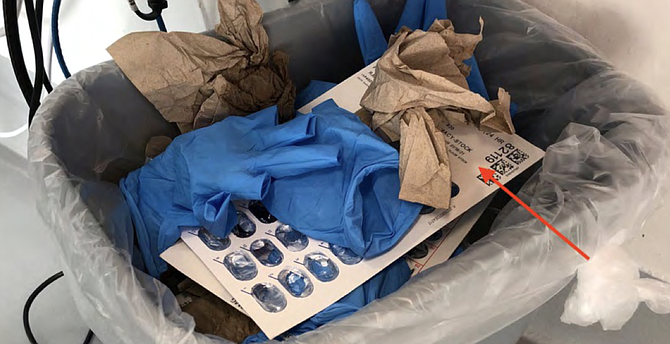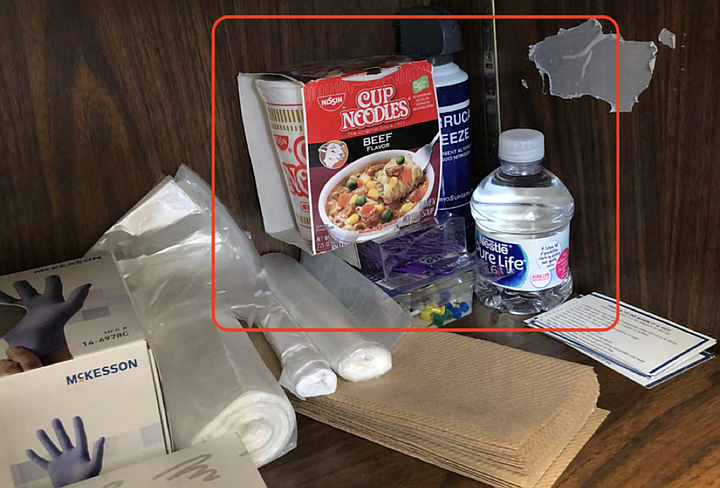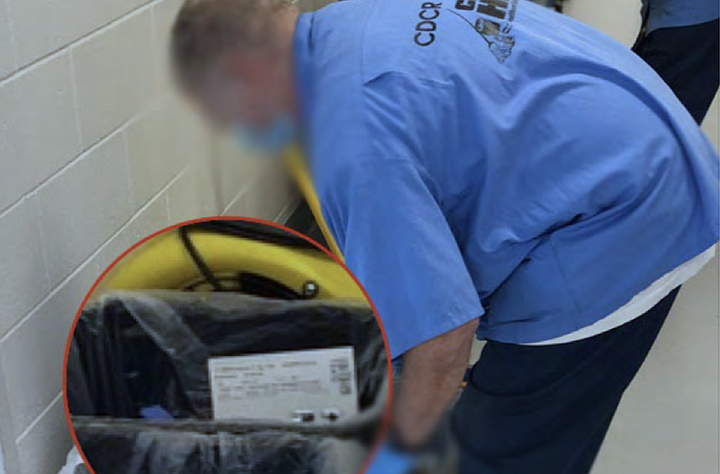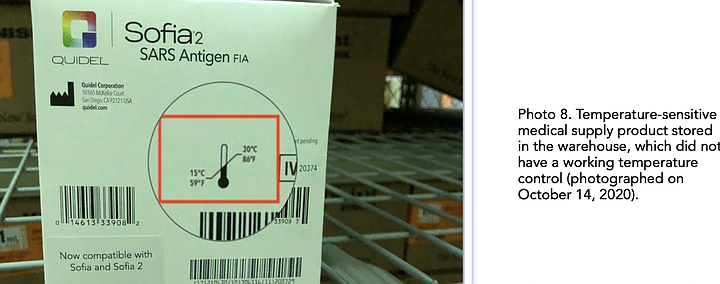 Facebook
Facebook
 X
X
 Instagram
Instagram
 TikTok
TikTok
 Youtube
Youtube

The 3,786 or so inmates at California’s Donovan Correctional Facility on Otay Mesa, a half mile from the Mexico–United States border, are getting generally so-so medical care, says a new audit by the state’s Office of Inspector General, with plenty of room for improvement remaining.
The newly released Medical Inspection Report, dated July of this year and revised September 7, rates overall medical services at the prison complex as Adequate, landing it between Proficient and Inadequate on a three-tiered scale according to findings by the auditors, consisting of “a team of physicians and nurse consultants.”

The group “reviewed 72 detailed cases” at the prison involving 1,004 “patient-related events. After examining the medical records, our clinicians conducted a follow-up on-site inspection in December 2020 to verify their initial findings.”
Though Donovan got good marks for the condition of its medical records system and response to medical emergencies, including quick handling of “opioid overdoses,” the prison was cited for a litany of failures in other areas, including so-called medical management.
“There were lapses in managing new medications, chronic care medications, hospital return medications, specialized medical housing medications, and transfer medications,” the audit says.
In particular, the prison “did poorly managing patients on tuberculosis medications. Patients were not receiving their TB medications timely. The institution did not complete monitoring at all required intervals. In addition, the nursing staff did not appropriately conduct TB screening timely.”

“Patients did not always receive their chronic care medications within the required time frames. There was poor medication continuity for patients returning from hospitalizations, for patients admitted to specialized medical housing, for patients transferring within [R.J.Donovan], and for patients laying over at [R.J.Donovan].”
Protecting the institute’s medical supplies from would-be miscreants was found to be problematic.
The “medical warehouse did not have an effective system for maintaining control of sharps (needles used to administer medications) in the warehouse; it did not account for its inventory of sharps; it did not track the sharps that were removed from the warehouse.

“Specifically, the clinic’s health care manager reported that nursing staff can walk directly to the sharps supplies in the warehouse, remove any number of needles from any boxes, sign for the needles in the warehouse logbook, and leave. Warehouse staff did not consistently dispense needles to health care staff; staff could help themselves.”
Regarding inmate access to care, “Our clinicians reviewed 139 clinic provider appointments and identified six deficiencies, the report says. “[R.J.Donovan] performed inadequately in both compliance testing and case review.”
“In case 1, the patient underwent a surgical procedure on his great toe, and a provider requested a clinic provider appointment in 14 days; however, the appointment occurred more than one month later.
‘In case 53, the patient had knee pain and requested to see his provider, and a nurse requested a clinic provider appointment within 14 days; however, the appointment did not occur. One month later, the patient submitted another request to see his provider for knee pain, and the provider saw the patient then.”
“Multiple clinics and the medical warehouse contained expired medical supplies, emergency medical response bag logs either were missing staff verification or inventory was not performed, and staff did not regularly sanitize their hands before or after examining patients.”
“The [Office of Inspector General] rated this indicator inadequate.”
“One clinic had examination rooms that lacked visual privacy for conducting patient examinations and had confidential medical records that were accessible to unauthorized individuals,”
Keeping prison clinics microbe-free was also cited as a challenge.
“The staff restroom and medication room in administrative segregation, Housing Unit 6, were not being properly cleaned,” says the report.
“The staff reported the Prison Industry Authority Healthcare Facilities Maintenance program cleaned the area as a courtesy once per week.
“However, there had been no additional cleaning beyond that done for the courtesy visit. As a result, we noted that the medication room floor and staff restroom vents were in an unsanitary state with accumulated grime.”
Other negative maintenance findings called out during visual inspection by the audit team included Water Damage on Medical Warehouse Ceiling, Dirty Vents in Staff Restroom, Unsanitary Medication Cart Drawer, Medication Cart Drawer Containing Soiled Gloves, Medications Stored on Floor, and Food Items Stored with Medical Supplies.
In a June 24 response attached to the report, Terra Adams of California Correctional Health Care Services wrote that her agency “acknowledges” the inspector general’s findings. “Your efforts have advanced our mutual objectives of ensuring transparency and accountability in CCHCS operations.”


The 3,786 or so inmates at California’s Donovan Correctional Facility on Otay Mesa, a half mile from the Mexico–United States border, are getting generally so-so medical care, says a new audit by the state’s Office of Inspector General, with plenty of room for improvement remaining.
The newly released Medical Inspection Report, dated July of this year and revised September 7, rates overall medical services at the prison complex as Adequate, landing it between Proficient and Inadequate on a three-tiered scale according to findings by the auditors, consisting of “a team of physicians and nurse consultants.”

The group “reviewed 72 detailed cases” at the prison involving 1,004 “patient-related events. After examining the medical records, our clinicians conducted a follow-up on-site inspection in December 2020 to verify their initial findings.”
Though Donovan got good marks for the condition of its medical records system and response to medical emergencies, including quick handling of “opioid overdoses,” the prison was cited for a litany of failures in other areas, including so-called medical management.
“There were lapses in managing new medications, chronic care medications, hospital return medications, specialized medical housing medications, and transfer medications,” the audit says.
In particular, the prison “did poorly managing patients on tuberculosis medications. Patients were not receiving their TB medications timely. The institution did not complete monitoring at all required intervals. In addition, the nursing staff did not appropriately conduct TB screening timely.”

“Patients did not always receive their chronic care medications within the required time frames. There was poor medication continuity for patients returning from hospitalizations, for patients admitted to specialized medical housing, for patients transferring within [R.J.Donovan], and for patients laying over at [R.J.Donovan].”
Protecting the institute’s medical supplies from would-be miscreants was found to be problematic.
The “medical warehouse did not have an effective system for maintaining control of sharps (needles used to administer medications) in the warehouse; it did not account for its inventory of sharps; it did not track the sharps that were removed from the warehouse.

“Specifically, the clinic’s health care manager reported that nursing staff can walk directly to the sharps supplies in the warehouse, remove any number of needles from any boxes, sign for the needles in the warehouse logbook, and leave. Warehouse staff did not consistently dispense needles to health care staff; staff could help themselves.”
Regarding inmate access to care, “Our clinicians reviewed 139 clinic provider appointments and identified six deficiencies, the report says. “[R.J.Donovan] performed inadequately in both compliance testing and case review.”
“In case 1, the patient underwent a surgical procedure on his great toe, and a provider requested a clinic provider appointment in 14 days; however, the appointment occurred more than one month later.
‘In case 53, the patient had knee pain and requested to see his provider, and a nurse requested a clinic provider appointment within 14 days; however, the appointment did not occur. One month later, the patient submitted another request to see his provider for knee pain, and the provider saw the patient then.”
“Multiple clinics and the medical warehouse contained expired medical supplies, emergency medical response bag logs either were missing staff verification or inventory was not performed, and staff did not regularly sanitize their hands before or after examining patients.”
“The [Office of Inspector General] rated this indicator inadequate.”
“One clinic had examination rooms that lacked visual privacy for conducting patient examinations and had confidential medical records that were accessible to unauthorized individuals,”
Keeping prison clinics microbe-free was also cited as a challenge.
“The staff restroom and medication room in administrative segregation, Housing Unit 6, were not being properly cleaned,” says the report.
“The staff reported the Prison Industry Authority Healthcare Facilities Maintenance program cleaned the area as a courtesy once per week.
“However, there had been no additional cleaning beyond that done for the courtesy visit. As a result, we noted that the medication room floor and staff restroom vents were in an unsanitary state with accumulated grime.”
Other negative maintenance findings called out during visual inspection by the audit team included Water Damage on Medical Warehouse Ceiling, Dirty Vents in Staff Restroom, Unsanitary Medication Cart Drawer, Medication Cart Drawer Containing Soiled Gloves, Medications Stored on Floor, and Food Items Stored with Medical Supplies.
In a June 24 response attached to the report, Terra Adams of California Correctional Health Care Services wrote that her agency “acknowledges” the inspector general’s findings. “Your efforts have advanced our mutual objectives of ensuring transparency and accountability in CCHCS operations.”
Comments